-
Miscellaneous catalogues
(back to top)
- J, H, Ks catalogues of 14,822,341 point
sources for a 40 deg2 area of the LMC,
2,769,682 sources for an 11 deg2 area of the SMC, and 434,145 sources for a 4 deg2 area of the Magellanic Bridge (MB). The 10σ
limiting magnitudes are 18.8, 17.8, and 16.6 mag at J, H, and K_s,
respectively. The online catalog can be found at http://pasj.asj.or.jp/v59/n3/590315/590315-frame.html.
(from Kato et al., 2008EAS....33..139K)
(figs: from left to right: Color-Color diagrams of LMC, SMC and Magillanic bridge
(MB), Color-magnitude diagrams of LMC, SMC and MB)
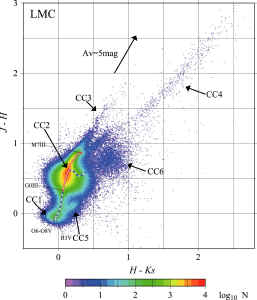 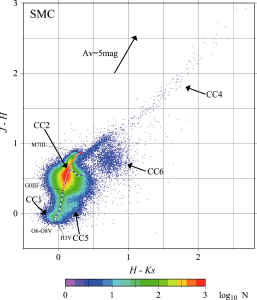 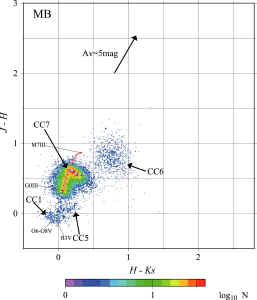 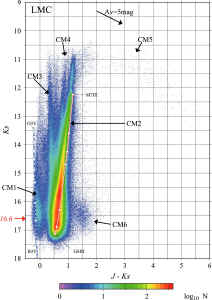 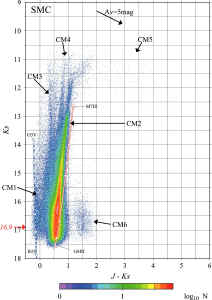 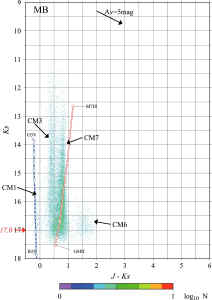
-
They identified 795 new red AGB variables (78 Mira type, 717 SR+L type). (from Usatov & Nosulchik, 2008OEJV...87....1U)
-
They extracted ~2000 variables from the Spitzer SAGE survey of LMC at two epochs. Most of
them are AGB stars. (from Vijh et al., 2008arXiv0811.0408V)
-
List of stars
with known distance
(back to top)
- List of M stars
(back to top)
- They present a highly reliable flux-limited census of 18949 point sources in the Galactic midplane that
are selected from Spritzer GLIMPSE I and II survey
(274 deg^2) with intrinsic red middle IR colors ([4.5]-[8.0]>=1).
About 50-70% of them are YSOs, 30-50% are AGB stars, 2-3% are PNe or background galaxies. 1004 red sources in the GLIMPS II region (mostly
Mira type AGB stars) show significant (>=0.3mag) variability at 4.5 and 8 um
but with constant color [4.5-8.0] (incomplete due to 4.5um
saturation and only two epochs). This is to date the largest uniform
census of AGB stars and high- and intermediate-mass YSOs in the Galaxy.
A machine readable version of the catalog is here.
(from Robitaille et al., 2008AJ....136.2413R)
-
List of normal
M stars (back to top)
- List of peculiar M stars (back to top)
- "Water foundtain" stars.
They are
Oxygen rich AGB stars that may have entered post-AGB stage. They show high
velocity outflow in water maer lines. They are found by H2O maser
spectroscopy at 22 235.08 MHz and verified by VLBI observation in the H2O
maser line. These sources are very rare. Presently, there are only about 10
such sources found in recent years. Here is a list of all of them:
- IRAS 15103-5754 (PN G320.9-00.2), a water fountain in a PN candidate, Vsys = ~30 km/s, Vexp = ~ 40 km/s from the H2O maser. (Suarez et al., 2009A&A...505..217S) .
- IRAS 15445-5449 (OH 326.5 -0.4), an evolved post-AGB star with highly unusual maser
properties.
- IRAS 15544-5332 (OH 325.8 -0.3), probably a massive
star. (Deacon et al., 2007ApJ...658.1096D)
- IRAS 16342-3814 (OH 344.1 +5.8, OH 344.07 +5.84),
(see Likkel et al., 1992, A&A 256, 581; Morris et al., 2003; Claussen et al., 2004;
Sahai 1999; CO 1-0 not detected by Loup et al., 1990)
- IRAS 16552-3050 (PN PM 1-120),
found by Suarez et al. (2007).
- IRAS 18043-2116 (OH 9.1 -0.4), is a young post-AGB star that is highly likely to be a
water-fountain source.
- OH 12.8-0.9 (IRAS 18139-1816? not sure yet),
found by Boboltz and Marvel, 2005. See more details in Gomez et al., 1994;
Baud et al., 1985; Baud et al. 1979; Dickinson & Turner 1991; Recent
measurement by Boboltz and Marvel, 2007 (2007ApJ...665..680B): bipole H2O
maser arcs 12-20 mas apart, perpendicular to outflow axis, with
relative proper motion of 2.7 mas/yr (105 km/s at 8kpc), spatial
expansion velocity 58 km/s with inclination angle of 24 deg, 3D
acceleration of masers is 0.63km/s/yr, with dynamic age of ~90 years.
- IRAS 18113−2503 (the newest member, see Gomez et al., arXiv:1105.5202)
- IRAS 18286-0959
- IRAS 18450-0148 (W 43A, OH 31.0 +0.0),
also known as W43A, verified by Imai, 2002, Nature 417, 829 and Imai et al.,
2004.
- IRAS 18460-0151 (OH 31.0 -0.2),
from Jun-ichi, private communication; te Lintel Hekkert et al., 1991.
- IRAS 18596+0315 (OH 37.12 -0.85, OH 37.1 -0.8, PN PM 1-275), (Claussen & Sahai, 2003)
- IRAS 19134+2131 (IRAS 1913+215P09),
detail study by Imai et al., 2004. More work from Hu et al., 1994; Engels et al., 1984;
Likkel et al., 1992, A&A 256, 581; Likkel et al., 1991.
- IRAS 19190+1102 (PN PM 1-298),
could
be a water fountain star, but show strange maser velocities.
-
M
stars showing carbon-chemistry molecular lines (back to top)
-
M stars in binary (back to top)
-
HD 188037 (=IRC
+20439): Ir variable, skewed CO line profiles,wide binary
(why an MS A star forms binary with an M
star?!)(from Jura et al., 1997ApJ...485..341J)
-
Alpha Sco: A visual binary with
M1.5IAB + B2.5V. O-rich M giant? (from van der Hucht et al., 1980A&A....82...14V)
-
Alpha Her: A visual bianry with a
red giant. O-rich M giant? (from Thiering & Reimers, 1993A&A...274..838T)
-
o Ceti (=Mira):
A binary with Mira A an M giant and Mira B a WD. (from Reimers
& Cassatella, 1985ApJ...297..275R)
It also shows bipolar jets (from meaburn et al., arXiv:0903.1966)
-
Other M stars with
non-standard CSEs (back to top)
-
RV Boo: SR variable, Keplerian
disk, 4.2"x3.3". (from Bergman et al., 2000A&A...353..257B)
-
X Her: SR variable, bipolar outflow (from Kahane & Jura, 1996A&A...310..952K)
-
OH 231.8+4.2: A M star with
bipolar outflows, with an opaque, flared disk in the base of the
outflows (from Jura et al., 2002ApJ...574..963J)
-
IRAS
01037+1219 (CIT 3, IRC +10011): an OH/IR star with bipolar outflow found.
-
IRAS 19312+1950: An O-rich AGB
star with bipolar nebula and S-shaped polarized arm.
But most of the gas may come from ambient dark cloud.
(Murakawa, et al., A&A, 2007, accepted)
-
EP Aql: An M star with composite
CO line profile, double wind? (from
Winters et al., 2007A&A...475..559W)
-
R Hya show special CSE. (from Teyssier et al., 2006A&A...450..167T);
it also show detached shell in the IRAS 60 and 100um images (see
Hashimoto et al., 1998A&A...329..213H).
- List of S stars
(back to top)
- Peculiar S stars (back to top)
- List of carbon stars
(back to top)
-
List of normal C stars (back to top)
-
The 3rd edition of CGCS3 (Stephenson’s General Catalogue of Cool Galactic Carbon Stars)
include almost all carbon stars (6891 entries) known by 2001. (See the
details in Alksnis et al. 2001BaltA..10....1A. N.B.: some C stars identified through
[K-l]-[12-25] color-color diagram criterion can be wrong. See the
example of wrong identities found by Chen & Gao, 2002ChJAA...2..169C and Chen et al., 2003NewA....8..719C)
-
A revised Carbon star catalogue by
Guandalini et al., 2006A&A...445.1069G.
-
Visual carbon
stars (see the 370 C stars studied by Bergeat et al., 2002A&A...390..967B on H-R diagram.)
-
Infrared carbon stars (63 IR carbon stars newly identified by the 11.2 um SiC dust emission and IRAC R12-R23
color indices criteria by Chen & Chen, 2003AJ....125.2215C)
Total number of known IR carbon stars is 348 (see Chen & Shan, Ap&SS, 2008, in press)
-
Extreme carbon stars (all 55 Extreme C stars known in literature in and
before 2006, collected by Chen & Shan, 2007Ap&SS_312__
85C)
-
J-type carbon stars (see the 103
J type C stars collected by Chen et al., 2007AJ....134..214C)
-
Carbon stars with ISO SWS spectra (a private collection)
-
Galactic halo carbon stars (see 27 stars
in Mauron et al., 2004A&A...418...77M,
21 stars in Mauron et al., 2005A&A...438..867M,
and 23 stars in Mauron et al., 2007A&A...475..843M)
- AKARI/IRC and Spitzer observatioins a sample of extremely red AGB stars to be C-rich and only show molecular absorption features such as C2H2 at 13.7um, indicative of early post-AGB stars. (from Garcia-Hernandez et al., 2009arXiv0904.4158G)
- List of
peculiar C stars (back to top)
-
Bipolar C stars (back to top)
--> C-rich counterparts of water fountain stars?
- CRL 618: a C-rich PPN with fast bipolar outflows (~ 100 km/s) were clearly identified by Herschel/HIFI observation of high-J CO lines. The asymmetry of the 12CO 16-15 line is not explained with current models. (Bujarrabal et al., arXiv:1007.1570)
- IRAS 08544+4431: an (C type?) postAGB star with disk and bipolar jets (from Dinh-V-Trung, 2009ApJ...692.1382D)
- Silicate C
stars (back to top)
-
BM Gem:
composite CO line profiles (FWHM~1km/s) , circumbinary disk? (from
Kahane et al., 1998ApJ...500..466K)
-
EU And -- An silicate carbon star with
H2O maser detected and imaged with VLBA. CO2 also detected. (from Ohnaka
& Boboltz, 2008, A&A, accepted). The composite CO spectrum
indicates circumbinary disk around
the star. (from Jura & Kahane, 1999ApJ...521..302J)
-
IRAS 03201+5459: an AGB star with
9.7um silicate absorption and 3um C2H2+HCN absorption which is
typical in C stars. (from Jiang et al., 2000A&A...362..273J)
-
-
C stars in
binary (back to top)
-
IRC -20131 (=CS776): A binary with a C star and an A3
V-III companion. (from Le Bertre, 1990A&A...236..472L)
-
IRAS 18006-3213: VLTI/MIDI IR mapping in N band prefer a
circumbinary disk. (form Deroo et al., 2007A&A...467.1093D)
-
-
C
stars with non-standard CSEs (back to top)
-
CRL 2688:
with shells in CSE.
-
CRL
3068: with Archemidean spiral pattern in its CSE.
-
IRAS 17150-3224: with detached shell in CSE.
-
TT Cyg: A hollow shell like radio map of
CO lines were found in the CSE of this star, which are thought to be
possibly produced by helium flash (Olofsson et al., 1990A&A...230L..13O and Olofsson et al., 1996A&A...311..587O ). Lucas et al., 1999, IAUS, 191, 305 reviewed interometry observations of AGB CSE before 1999 and also show an astonishing
narrow ring like CO image around TT Cyg. (channel
maps of CO around TT Cyg)
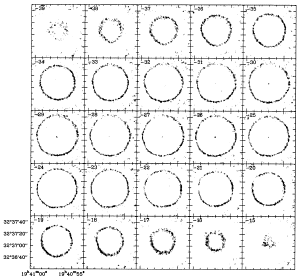
-
S Sct: show detached
shell in CO lines (from Olofsson et al., 1996A&A...311..587O)
-
V644 Sco: show detached
shell in CO lines (from Olofsson et al., 1996A&A...311..587O)
-
R Scl (SMA observation of CO,2-1 in carbon star R Scl showed an expanding ring like
structure and a inner newly ejected shell in the center, which demonstrate the
episodic mass loss processes., from Dinh-V-Trung et al., 2008, to be
published. Channel maps of the CO observation can be found here.
or look below)
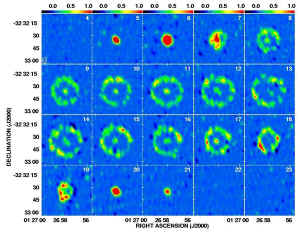
-
CW Leo (IRC
+10216):
In the review by Lucas et al., 1999, IAUS, 191, 305,
distribution of different molecular clumps that were recovered by mm
molecular line interferometry show some arc like pattern, which
resembles the arc like pattern found in the V band image taken by HST (Leao et al. 2006A&A...455..187L).
(distribution of molecular cloumps in CSE)
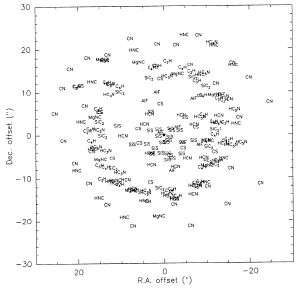
-
U Ant (IRAS
10329-3918): a star with detached CSE ( Olofsson et al., 1996A&A...311..587O) and showing double peaked
line profiles in CO,1-0 and 2-1 lines (from Nyman et al., 1992A&AS...93..121N).
The IRAS 60 and 100um image also show a detached
dust shell (Izumiura et al., 1997A&A...323..449I).
-
Y CVn: ISO 90 and 160 um image of this J-type carbon star showed a detached dust shell. (Izumiura et al., 1996A&A...315L.221I)
-
U Hya: A C star whose IRAS 60 and 100 um images showed large detacted dust shell. (Waters et al., 1994A&A...281L...1W)
-
-
C stars
with peculiar IR colors (back to top)
- IRAS 17375-3652, an infrared C star appearing in region IIIb on the IRAS color-color diagram where extreme C stars appear.
(from Chen & Shan, 2007Ap&SS_312__ 85C)
-
IRAS 22165+4331, an extreme C star appearing in region I on the IRAS color-color diagram where stars usually show atmospheric emission. This star could be coincident with another star along the line of sight (Cohen
& Hitchon, 1996AJ....111..962C).
Dual-period variation is also seen by (Alksnis et al. 1997BaltA...6..377A).
(from Chen & Shan, 2007Ap&SS_312__ 85C)
-
-
List of C stars in
LMC/SMC (back to top)
- Thirteen extreme C stars are identified in LMC using Spitzer IRAC and
MIPS data. They have extremely red
mid-IR colors, SiC and C2H2 absorption and broad MgS emission. They
are estimated to have much higher mass
loss rate (0.4~2x10^-4 Msun/yr) than C stars in the Milky Way Galaxy. How the C stars attain such high mass loss rate is
still a problem. (from Gruendl et al., 2008ApJ...688L...9G)
see the table below.
-
|
Spitzer source ID
|
IRAS name
|
|
050231.49-680535.8
|
…
|
|
050343.02-664456.7
|
IRAS05036-6649
|
|
050405.60-682340.3
|
IRAS05042-6827
|
|
051301.75-693351.0
|
IRAS05133-6937
|
|
051811.70-703027.0
|
IRAS05187-7033
|
|
051848.36-693334.7
|
IRAS05191-6936
|
|
052540.63-700827.2
|
IRAS05260-7010
|
|
052937.89-724952.9
|
IRAS05305-7251
|
|
053044.10-714300.5
|
IRAS05315-7145
|
|
054134.73-694209.3
|
IRAS05420-6943
|
|
054859.98-703322.5
|
IRAS05495-7034
|
|
055026.08-695603.1
|
IRAS05509-6956
|
|
055133.60-711933.9
|
IRAS05522-7120
|
|
|
- List of PPNs/post-AGB stars
(back to top)
- AGB/post-AGB stars with PdBI CO,1-0/2-1 mapping data. Given parameters: flux,
radii, position, mass loss rate. A empeircal relation between CO
photodissociation radius and CO,1-0 measured radius is also given. They
found that most of the observed sources have optically thick CO line
that has CO(2-1)/(1-0) ratio ~ 4. They derived a relation between CO
photodissociation radius R(CO) and measured HWHM CO radius theta(CO):
R(CO) = 1.5 * theta(CO) + 8.4". (from Neri et al., 1998A&AS..130....1N)
(figure: table of source and CO
quantities, map parameters.)
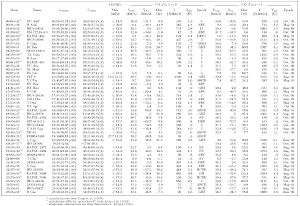 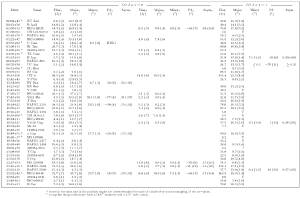
- PPN/PN with low 12C/13C ratio: (back to top)
--- O-rich stars ---
- Post-AGB stars in binary (back to top)
- IRAS 08544-4431: An F-giant in a
binary with P=499d, f=0.02Msun, surrunded by dusty disk. (from Maas
et al., 2003A&A...405..271M)
- PPNs with chemical dichotomy (back to top)
- AKARI/IRC observation revealed three PPNs that need a mixture of silicates and carbon-rich dust to fit their IR SED. (Bunzel et al., 2009arXiv0904.4134B)
- List
of RSG
(back to top)
- A list of 25 mass lossing M supergiants in the solar
neighbourhood (< 2.5kpc, 20Msun type, L>10^5Lsun). (from Jura
& Kleinmann, 1990ApJS...73..769J)
- Betegeuse
- Antares
- Alpha Her
- VY CMa
- VX Sgr
- HD 179821 (=RAFGL 2343):
a G-type supergiant of perhaps 30 M_solar with a detached dust shell. (from
Jura & Werner, 1999ApJ...525L.113J)
- µ Cep: An M supergiant with shells. (mauron 1997)
-
List of
other peculiar evolved stars (back to top)
- Double outflow stars: (click to (un)fold contents) (back to top)
- o Ceti (Planesas et al. 1990ApJ...351..263P, 1990ApJ...364L...9P),
spectrum by Knapp et al., 1998ApJS..117..209K.
- PI1 Gru (Sahai 1992A&A...253L..33S),
spectrum by Knapp et al., 1998ApJS..117..209K.
- RS Cnc (Neri, R., et al. 1998A&AS..130....1N),
spectrum by Knapp et al., 1998ApJS..117..209K.
- X Her (Kahane & Jura, 1996A&A...310..952K),
spectrum by Knapp et al., 1998ApJS..117..209K.
- R Scl (SMA observation of CO,2-1 in carbon star R Scl showed an expanding ring like
structure and a inner newly ejected shell in the center, which demonstrate the
episodic mass loss processes., from Dinh-V-Trung et al., 2008, to be
published. Channel maps of the CO observation can be found here.
or look below)

- Special AGB stars with mixed
chemistry: (click to (un)fold contents) (back to top)
- V778 Cyg -- A silicate carbon star (Szczerba et al., 2007arXiv0704.0557S)
- IRAS 06238+0904 -- An genuine carbon star with OH maser (Szczerba et
al., 2007arXiv0704.0557S)
-
- AGB stars with
patterns in the CSE: (click to (un)fold contents) (back to top)
- IRAS 10491-2059 (V
Hya): Asymmetrical CO line profile was found by mapping (Kahane et al., 1988 and Tsuji et al., 1988) to be
originated from a bipolar region. (from
Nyman et al., 1992A&AS...93..121N)
- U Cam: HCN (J=1-0) and CN(N=1-0) images of
this star showed shell like structure (Lindqvist et al., 1996A&A...305L..57L).
Later observation of CO 1-0, 2-1 by PdBI of U Cam confirmed similar
pattern. So the pattern should be a density enhanced shell. (Lindqvist et al., 1999A&A...351L...1L)
- CIT 6, Chi Cyg, WX Psc (from
Teyssier et al., 2006A&A...450..167T)
- R Leo and W Hya: AGB star with asymmetric CSE (from
Lattanzi et al., 1997ApJ...485..328L)
- Evolved stars
with narrow molecular line (disk?) (back to top)
- IRAS 20000+4954 (Z Cyg): A mira variable with high spatial
velocity of ~150 km/s but narrow OH maser and CO emission lines:
Vexp = 2.1 km/s for OH and 4.5 km/s for CO. (see Josselin et al., 1998A&AS..129...45J)
- IRAS 20547+2047 (U Equ): OH and H2O masers showed narrow lines
with Vexp = 4 km/s and 5 km/s respectively, but a very weak CO,2-1
line showed a higher Vexp = 16 km/s,
typical for AGB stars. (see Josselin et al., 1998A&AS..129...45J)
Furthermore, its IRAS 25um/12um colour indicates optically thin dust
while its IRAS LRS showes deep silicates absorption and strong 60 um
emission, which indicates a cold edge-on
Keplerian disk with bipolar nobulosity around the star. (from
Barnbaum et al., 1996)
-
List of Herbig
Ae/Be stars
(back to top)
- List of SFRs (back to top)
- List of ourflow sources: They collected all 391 known outflow sources from literature before Feb. 28 of 2003. Among them, 139 are high mass objects (judged from source mass or outflow mass). It is the first time to find a correlation between the outflow mass and the luminosity of the driving source. The outflows in massive objects can be two orders of magnitude more massive than in low mass stars but less collimated than in the latter. 90% of low mass outflows are associated with HH objects. 61% of high mass outflows are associated with H2O masers. 12% of the whole sample show signitures of infall or collapse. (from Wu et al., 2004A&A...426..503W)
- ---------------------- massive SFRs ---------------------
- (Palla et al., 1991A&A...246..249P)
They selected a sample of 260 cold molecular clouds that could be massive SFRs on the basis of their IRAS colors (limited to |b|<=10deg, DEC>-30deg). 125 of them are classified to be associated with UCH II regions ([25-12]>0.57 and
[60-12]>1.3, Wood and Churchwell, 1989ApJ...340..265W), while the others are considered as at even earlier stages..
- ---------------------- low mass SFRs ---------------------
- ---------------------- SFRs in LMC and SMC---------------------
- (Gruendl & Chu, 2009ApJS..184..172G)
1172 YSOs in LMC are selected from Spitzer IRAC and MIPS photometry data, together with 1075 background galaxies in the same directions.
|
![]()